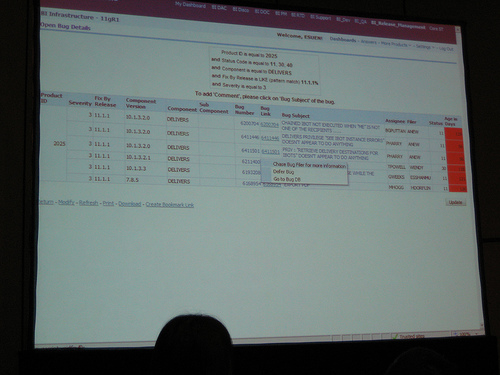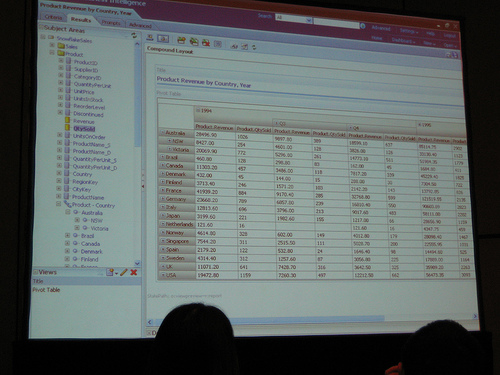OOW2007: Next-Generation Semantic Layer, Ed Suen
After going along to the "Oracle's BI Vision and What It Means to Hyperion Customers" session over at the Marriott hotel, the session I was particularly looking forward to this morning was Ed Suen's session on what's coming up in the semantic model layer for Oracle BI Suite Enterprise Edition. The session also went into what's happing with Answers Plus and the Action Framework, so it was a pretty good introduction to what's likely to be coming up in the 11g timeframe for BI EE. The roadmap sessions later on it the day and in the week will go into this into more detail, but here's the substance of Ed's talk.
Ed was the primary developer behind Cognos Impromptu, which introduced some of the concepts around managed reporting tools and semantic layers, he then went on to form nQuire with a few other people who are now mostly heading up the BI effort within Oracle. I went to Ed's talk last year on BI Suite Enterprise Edition best practices, so I was looking forward to today's session for a bit more detail on the future direction for the semantic layer.
Starting off, one of the key features of the semantic layer that the 11g timeframe will be exploiting is it's extensibility. Ed showed a demo of the semantic layer being extended to include search results (unstructured data) through web service calls, this depended on a new function called LOOKUP that allowed the BI server to read out to web service data. Ed also talked about the semantic model having a "public service provider interface", not sure if this was something that could be used to access the semantic model via a web service call, or something that the semantic model (or more properly, the BI Server) used to make it's web service calls.
Ed then went on to talk about "Insight into Action", and the Action Framework that's coming in 11g. The example shown was an Answers report that displayed a list of measure values; for one of the values, clicking on it showed a set of contextual menu items that could change depending on the value being displayed (i.e. a sort of "conditional formatting" for navigation items) - here's a quick photo I took of the example:

Of course the demo shown might not reflect the final UI, usual Oracle disclaimers apply.
The Action Framework idea seems to be a way of defining the different user interactions that can take place, using a metadata approach that you maintain in the Presentation Server. Typically, you'd define actions that would allow you to drill through to a transaction application, kick of a business process, enter some data into a system, all of these would be defined as Actions via a metadata framework that you could associate with Answers report columns, like you can associate columns with formats and navigation actions now. Hopefully we'll hear more on this later in the week, also I'll pop down to the demo grounds later on in the week to see if there are any live demos.
Ed also started to cover Answers Plus, the OLAP version of Oracle BI Answers that supports proper Discoverer-style drilling, Discoverer OLAP-style hierarchical selection of dimension members, calculated members, OLAP-style condition building, all with a DHTML interface similar to the current version of Answers. Again, the UI may change between now and the final release, but Ed showed a few screenshots, one of which is below:

Note the proper, embedded drilling, and the hierarchical dimension member selector down the left-hand side.
Finally, we got a preview of the new Scorecarding application, this will complement Answers and Dashboard and provide a balanced scorecard-style application for managing business goals. This looked particularly neat, in terms of what's coming up in the 11g timeframe this will obviously be a key application.
So, overall a great presentation. It was a little bit light on specifics about the integration of Essbase and other KPIs and calculations into the semantic model, I did ask Ed for more details on this but I think it's something that's still up for discussion. The parts on extensibility were interesting though - clearly the semantic model is being opened up so that unstructured, as well as structured, data can be referenced by it, and it'll be interesting to see how things such as KPIs and goals, more abstract-level bits of metadata, will be held within it in time.
One other thing that I almost forgot - Ed talked about the Data Mart Automation feature that's currently in the 10g version, and that will be extended in future releases - one of the longer-term aims for the platform is for it to be able to generate ETL routines to support more complex transformations, with the ETL functionality being able to be "function-shipped" to ETL tools such as ODI, in the same way that calculations can be function-shipped to underlying databases such as Oracle if the database can perform them more efficiently.